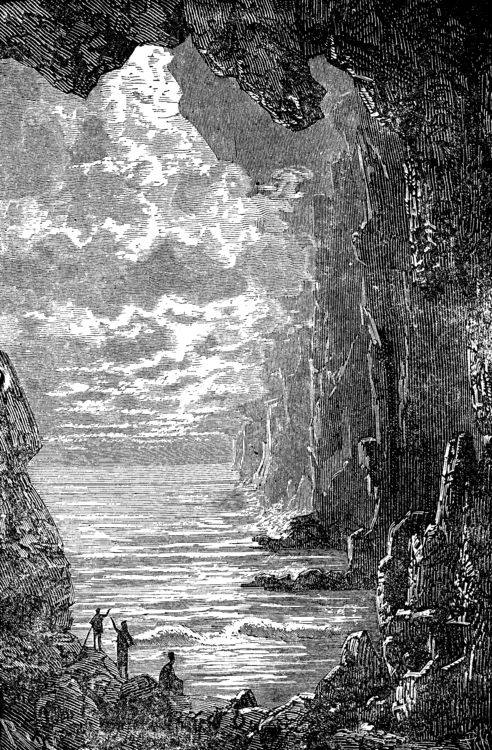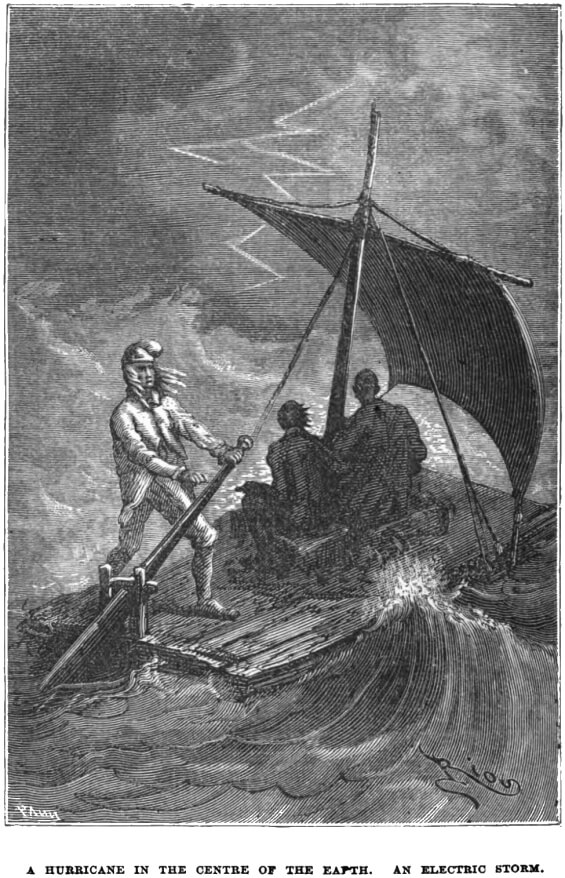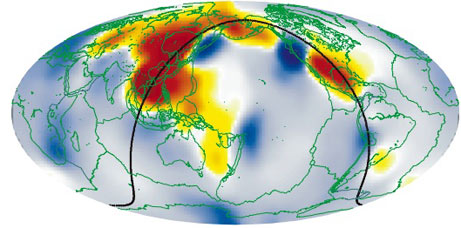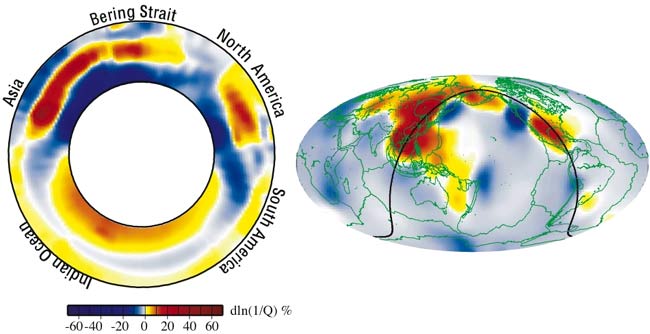|
|
|
|
Jules
Verne
 In the late 1800's Jules Verne gave us some fantastic tales with sketches. In recent years there have been many new discoveries made that would seem to back up Jules Vernes wild stories... so was he there?... or did he dream it?... perhaps a trip to the future? Below is a sketch of the giant cave with it's own ecosystem and lake    Below is Huge Underground "Ocean" Found Beneath Asia in 2007 |
|
|
..
A map depicts large areas of
wet underground rock (shown in red) as detected
by seismic waves. Scientists
studying these waves discovered a giant "ocean"
of water under east Asia
that contains about as much water as the Arctic
Ocean. Map courtesy Eric
Chou/WUSTL
Huge
Underground "Ocean" Found
Beneath Asia
A giant blob of water the size of the Arctic Ocean has been discovered hundreds of miles beneath eastern Asia, scientists report. But nobody will be exploring this sea by submarine. The water is locked in moisture-containing rocks 400 to 800 miles (700 to 1,400 kilometers) beneath the surface. "I've gotten all sorts of emails asking if this is the water that burst out in Noah's flood," said the leader of the research team, Michael Wysession of Washington University in St. Louis. "It isn't an ocean. [The water] is a very low percentage [of the rock], probably less than 0.1 percent." Given the region's size, however, that's enough to add up to a vast amount of water. Earthquakes Reveal "Ocean" Wysession and former graduate student Jesse Lawrence discovered the damp spot by observing how seismic waves from distant earthquakes pass through Earth's mantle. The wet zone, which runs from Indonesia to the northern tip of Russia, showed up as an area of relatively weak rock, causing the seismic waves to lose strength much more rapidly than elsewhere (see map of Asia.) The water got there by the process of plate tectonics, in which sections of the Earth's crust shift. This process caused the ocean bottom to be pulled beneath continental plates all around the Pacific Rim. Normally, Earth's internal heat bakes the water out of the rocks before it gets more than 60 miles (100 kilometers) deep. The water then escapes upward as volcanic gas. But along the eastern Pacific Rim, conditions allow the rock to be drawn much deeper before the moisture is cooked out. The find may help scientists better understand the formation of volcanic regions such as those in Iceland, Hawaii, and Yellowstone National Park. One theory suggests that these areas are volcanic because hot spots deep within the Earth's interior melt the underlying rock like a giant blowtorch, producing large quantities of lava. Wysession says that the presence of water may allow such hot spots to melt more rock, thereby creating more lava. "If you add water [to the rock] you can get an increased amount of melting," he said. "There's a consensus that not all hot spots are equal. Some are hot spots; some are wet spots." Wysession and Lawrence report their findings in a study published by the American Geophysical Union. A Look at Earth's Fate The new study also reveals clues to Earth's long-term fate, says Norman Sleep, a geophysicist at Stanford University who was not involved in the project. When the planet was young, steam came from the deep interior to the surface as volcanic gas and eventually produced today's oceans. But as Earth's interior ages and cools, it becomes easier for water to return below the surface. "So, rather than degassing, now [Earth] may be losing water into the mantle," Sleep said. This gradual suction of water back below the surface may be a good thing for Earth's geological stability, he notes. Underground water acts as a kind of lubricant that allows plates in Earth's crust to keep shifting at their present rate, Sleep explains. This helps keep the thickness and elevation of the continents relatively stable. If things changed, he said, "we'd have Pike's Peak boat tours." Related Articles:
|
|
|
..
Scientists probing the Earth's
interior have found a large reservoir of water
equal to the volume of the
Arctic Ocean beneath eastern Asia. The left
figure is a slice through the
Earth, taken from the figure on the right,
showing the attenuation anomalies
within the mantle at a depth of roughly 620
miles. In both images, red
shows unusually soft and weak rock believed to
be saturated with water,
and the blue shows unusually stiff rock (yellow
and white show near-average
values). Credit: Eric Chou
By Ker Than,
LiveScience Staff
Writer
Scientists scanning the deep interior of Earth have found evidence of a vast water reservoir beneath eastern Asia that is at least the volume of the Arctic Ocean. The discovery marks the first time such a large body of water has found in the planet’s deep mantle. The finding, made by Michael Wysession, a seismologist at Washington University in St. Louis, and his former graduate student Jesse Lawrence, now at the University of California, San Diego, will be detailed in a forthcoming monograph to be published by the American Geophysical Union. Looking down deep The pair analyzed more than 600,000 seismograms—records of waves generated by earthquakes traveling through the Earth—collected from instruments scattered around the planet. They noticed a region beneath Asia where seismic waves appeared to dampen, or “attenuate,” and also slow down slightly. “Water slows the speed of waves a little,” Wysession explained. “Lots of damping and a little slowing match the predictions for water very well.” Previous predictions calculated that if a cold slab of the ocean floor were to sink thousands of miles into the Earth’s mantle, the hot temperatures would cause water stored inside the rock to evaporate out. “That is exactly what we show here,” Wysession said. “Water inside the rock goes down with the sinking slab and it’s quite cold, but it heats up the deeper it goes, and the rock eventually becomes unstable and loses its water.” The water then rises up into the overlying region, which becomes saturated with water [image]. “It would still look like solid rock to you,” Wysession told LiveScience. “You would have to put it in the lab to find the water in it.” Although they appear solid, the composition of some ocean floor rocks is up to 15 percent water. “The water molecules are actually stuck in the mineral structure of the rock,” Wysession explained. “As you heat this up, it eventually dehydrates. It’s like taking clay and firing it to get all the water out.” The researchers estimate that up to 0.1 percent of the rock sinking down into the Earth’s mantle in that part of the world is water, which works out to about an Arctic Ocean’s worth of water. “That’s a real back of the envelope type calculation,” Wysession said. “That’s the best that we can do at this point.” The Beijing anomaly Wysession has dubbed the new underground feature the “Beijing anomaly,” because seismic wave attenuation was found to be highest beneath the Chinese capital city. Wysession first used the moniker during a presentation of his work at the University of Beijing. “They thought it was very, very interesting,” Wysession said. “China is under greater seismic risk than just about any country in the world, so they are very interested in seismology.” Water covers 70 percent of Earth’s surface and one of its many functions is to act like a lubricant for the movement of continental plates. “Look at our sister planet, Venus,” Wysession said. “It is very hot and dry inside Venus, and Venus has no plate tectonics. All the water probably boiled off, and without water, there are no plates. The system is locked up, like a rusty Tin Man with no oil.” SOURCE: Live Science |
|
| FAIR USE NOTICE: This page contains copyrighted material the use of which has not been specifically authorized by the copyright owner. Pegasus Research Consortium distributes this material without profit to those who have expressed a prior interest in receiving the included information for research and educational purposes. We believe this constitutes a fair use of any such copyrighted material as provided for in 17 U.S.C § 107. If you wish to use copyrighted material from this site for purposes of your own that go beyond fair use, you must obtain permission from the copyright owner. | |
|
|


